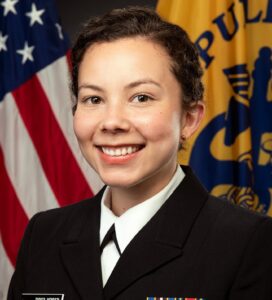Known affectionately as the “Disease Detectives,” participants in the Centers for Disease Control and Prevention’s two-year post-doctoral Epidemic Intelligence Service serve on the front lines of public health, participating in investigative and emergency response efforts—locally, nationally and internationally.
In recent years, EIS officers have been involved with the highest-profile emergencies worldwide, including pandemic-level viral concerns such as SARS-CoV-2, Mpox and Ebola, as well as earthquakes in Haiti and the wars in Ukraine and Gaza.
The Disease Detectives also hunt down the source of rare and unusual infections that lead to hospitalizations and deaths among U.S. citizens. This can include the growth and expansion of fungal diseases due to climate change and soil disturbances, including notable increases in tuberculosis cases and invasive mold infections that have become more deadly among COVID-19 patients with weakened immune systems.
University of Georgia graduates have served on the public health front lines and worked on these cases in recent years, becoming EIS officers after earning degrees in epidemiology and biostatistics at the College of Public Health. Through faculty mentorship, training and scholarship support, students gain the experience and skills they need to apply to the CDC’s prestigious 70-year program, and upon completion, move into careers across the world to tackle today’s public health problems.
Finding A Mentor
Long before Mechelle Claridy earned her PhD in epidemiology at UGA in 2022, she knew she wanted to work in public health to help mothers and children. When Claridy was just six weeks old, her mother died from pregnancy-related complications. This became a driving force throughout her life to understand maternal morbidity and mortality.

During her doctoral program research, she found Dr. José Cordero, a leading maternal and infant health researcher at CPH who has received multiple honors for his contributions to the epidemiological study of preterm births, birth defects and maternal health in the U.S. and Puerto Rico.
Cordero was “living the research he was doing” around maternal and childhood health, said Claridy. For her dissertation, Claridy focused on predictors and correlates of severe maternal morbidity and mortality in the U.S.
Cordero, who is an EIS alumnus himself, encouraged Claridy to pursue the program as she considered next steps. After stints in teaching and research, she wanted to gain experience in applied epidemiology —being out in the field and combating disease on the front lines—to become a well-rounded epidemiologist.

Black and African American EIS officers, including Mechelle Claridy, and Laboratory Leadership Service Fellows pictured at the 2023 EIS Conference. (Photo credit: CDC/ Lauren Bishop).
Claridy’s assignment fit with her long-held interests, serving on the maternal and child health epidemiology team in the reproductive health division. Among her projects, Claridy investigated how an increase in birthing hospital closures has affected travel time for women, as well as how fetal and neonatal death reporting has varied over time in Mississippi.
Claridy enjoyed the work so much that she decided to stay in federal government, and as of July, transitioned to a full-time position with the CDC as a health scientist. She now works on cerebral palsy surveillance with the National Center on Birth Defects and Developmental Disabilities. She also enjoyed being part of the largest cohort of Black women in EIS to date.
“The EIS program has been life-changing and is one of the best decisions I’ve ever made,” she said. “It gave me the exposure I needed to see the ins and outs of working in federal government, and I love it here.”
Fulfilling A Dream
While still in elementary school in San Juan, Puerto Rico, Yaribel Torres-Mendoza knew she wanted to be a veterinarian and follow in the footsteps of her cousin, who studied veterinary medicine and pathology at UGA. In high school, she attended the CDC Museum’s Disease Detective Camp, a competitive week-long summer program for juniors and seniors to learn about public health and emergency preparedness. When she visited UGA on a tour, she was drawn to the joint DVM/MPH degree.

“Although it may seem obvious for some why veterinarians should be involved with public health, some folks don’t see that yet, so it’s great to have that MPH component as a veterinarian when applying for jobs that may not be directly related to animal health,” she said.
When Torres-Mendoza applied for the EIS program, Cordero and DVM professors created an interview panel to prepare students for the application process. She fondly remembers that moment, as well as their strong mentorship and student advocacy.
With EIS, Torres-Mendoza was assigned to the Florida Department of Health’s epidemiology bureau, where she worked on investigations of rabies in Miami and the spread of Candida auris, a type of yeast that can cause severe illness among hospitalized patients and is often drugresistant. She and colleagues responded to major outbreaks in Miami, Orlando and Tampa and gave recommendations to hospital administrators, which made a difference.
“We saw a decrease in infections at hospitals and reduction in costs,” she said. “It was a unique experience. Sometimes in public health you’re able to not only describe the problem but also implement a solution, which is refreshing.”
After that, Torres-Mendoza completed the CDC’s Preventive Medicine Fellowship with the National Center for Emerging and Zoonotic Infectious Diseases, which helped her to hone skills in policy and grant management. Now she’s the CDC President’s Malaria Initiative Advisor in Mozambique, where she oversees a $29 million malaria portfolio and focuses on vectoral control, social and behavioral change and One Health.
“There are multiple ways to be a veterinarian and serve public health,” she said. “If you get too caught up in a specific vision, you may miss the opportunities around you.”
Building A Future

An interest in One Health—how human health, animal health and environmental health connect —also spurred John Rossow to pursue a DVM/MPH dual degree and become a public health veterinarian. Seeing the value in international experience, he pursued funding opportunities to research abroad, including the CPH’s Ann and Tipton Golias International Travel Fund in Epidemiology to travel to Colombia, where he tested rodents, livestock and dogs for the Zika virus.
His experiences fueled Rossow’s drive to apply for the EIS program, the “holy grail” of public health and applied epidemiology. He matched with the fungal disease team in the CDC’s Foodborne, Waterborne and Water Environmental Disease Division, where he became an expert on a novel fungal disease in Brazil and investigated outbreaks of Candida ores in long-term health care facilities.
“You can’t get that type of experience anywhere else,” he said. “You have a support system to back you up, incredible mentorship and an opportunity for leadership with guidance.”

Frontline One Health Mentor Workshop in El Salvador.
After that, Rossow continued to develop his love for crisis response, problem solving and global public health in the CDC’s Future Leaders in Infections and Global Health Threats (FLIGHT) program. He now serves as the One Health liaison for international work across the CDC’s Global Public Health Emergency Branch, where he remains involved with field epidemiology and develops new curriculum for humanitarian health worldwide. Rossow also guest lectures at multiple universities and aims to pay forward the support he received at UGA.
“The connections between the CDC and College of Public Health are invaluable, with Dr. Cordero and the alumni network able to share their experiences,” he said. “The Ann and Tipton Golias grant funded one of the most formative experiences of my life—these scholarships go a long way in creating hands-on opportunities that may not be possible otherwise.”
Creating A Legacy
 Florence Kanu felt a personal call to understand why Black women were experiencing such poor health outcomes and be part of the research team that would answer that question. As a Bill and Melinda Gates Millenium Scholar, she decided to pursue a PhD in epidemiology at UGA, where she researched preterm births alongside the Georgia Department of Public Health’s maternal and child health epidemiology section.
Florence Kanu felt a personal call to understand why Black women were experiencing such poor health outcomes and be part of the research team that would answer that question. As a Bill and Melinda Gates Millenium Scholar, she decided to pursue a PhD in epidemiology at UGA, where she researched preterm births alongside the Georgia Department of Public Health’s maternal and child health epidemiology section.
After graduation in 2019, Kanu wanted to understand maternal and child health programs at the global level. Cordero encouraged her to join EIS.
Before the COVID-19 pandemic, Kanu was evaluating the nutritional surveillance system in Uganda and completed a polio deployment in Zambia. When the pandemic began taking hold, Kanu joined several crisis deployments.
After EIS, Kanu joined the CDC’s Global Immunization Division, where she now evaluates the disease burden of hepatitis B and tetanus, conducts serological surveys and works with countries toward eliminating, in particular, maternal and neonatal tetanus.
“We recently returned from Guinea, which is in the process of receiving its official letter of elimination from the World Health Organization,” she said. “It’s one of the more rewarding experiences of my career.”

Dr. Kanu trains state and local healthcare workers in Enugu, Nigeria on the importance of timely hepatitis B birth dose vaccinations for newborns.
Kanu passes along these experiences to younger professionals at the CDC, where she also supervises the current EIS officers. Reflecting on the broad range of mentorship she received at the College of Public Health and CDC, she wants to give back and continue the UGA-CDC legacy.
“Every path into and through public health is so different and unique,” she said. “As a student, it can seem so abstract, but public health is a field where you can think about how you want to invoke change and what you want your story to be—and make a conscious effort to choose each day to be one step closer to that story.”






